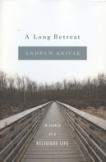Devout Dropout
The American Catholic (and secular) landscape is abuzz with the voluble presence of former Jesuits: from the stentorian television news commentator John McLaughlin to the California politician Jerry Brown to the scholar-journalist Garry Wills to the Pulitzer-Prize-winner Jack Miles to the popular historian Thomas Cahill. (Full disclosure: this non-famous reviewer was a Jesuit too, from 1959 to 1966.)
Now add to the list Andrew Krivak, a gifted Pennsylvania-born, London-based poet and writer, who spent eight years in the Jesuits before leaving—as most Catholic seminarians have, alas, been doing for over a generation—in 1998.
One thing most of these authors and activists have not talked much about is their own lives within, and their departure from, the Society. One exception might be the memoir Ours, by Francis E. Peters (1981), a distinguished professor of Islamic studies; but that book is chilly and unrevealing.
Like his fellow former priest turned writer, James Carroll in Practicing Catholic, Krivak is both passionate and eloquent; and he gives us a powerful picture of what has become a major narrative pattern in contemporary Catholicism: Young cleric/religious bails out after running aground on the shoals of celibacy. (Krivak met and fell in love with his wife-to-be at the Weston Jesuit School of Theology in Cambridge, Mass.)
The most striking impression anyone raised in the pre-Vatican II church is likely to carry away from The Long Retreat will be of how much seminary life has changed. The numbers have slumped dramatically (the combined New York and Buffalo Province of the Jesuits had 30 novices in its 1959 “class”; by 1989 it had five, of whom one persevered). Candidates are older, more educated and more experienced than they used to be. (Krivak entered with an M.F.A. in creative writing from Columbia.) Jesuit formation now offers—earlier and more than ever before—amazing opportunities for travel and adventure, spiritual, intellectual and otherwise: Krivak worked in Santo Domingo and the Bronx, studied at Yale, lived in Moscow and Slovakia, taught college courses in literature and, without being ordained, served as a chaplain in schools and hospitals.
Apart from solid companionship, Krivak got just about everything he could have desired, including private lessons in Russian and Slovakian, psychiatric care in periods of maladjustment, and so on. It’s all a far cry from the quasi-monastic life, with frequent, if largely symbolic, ascetical routines like self-flagellation, and endless restrictions (rural isolation, cassocks and clerical uniforms, rigid schedules ) of the old days. Of course, we do live in a radically different world. Candidates for the Jesuits now have to be tested for H.I.V./AIDS. Altogether, it sounds like a grand system: open-minded, innovative, supremely generous—if it weren’t for that dubious retention rate. One minor observation: judging from Krivak’s stories, whilst among themselves today’s Jesuits use four-letter words as frequently and vigorously as the rest of the male population.
Krivak’s title refers to the full-bore, 30-day version of the Spiritual Exercises of St. Ignatius Loyola, which all Jesuits make at the beginning and end of their training. Krivak, in fact, appears to have been rather more given to contemplation than many of his confrères. Always something of a loner, he had been drawn by the example of Thomas Merton and the Trappist ideal of silence and seclusion. An instinctively prayerful person, he did not go through the usual doubts and questionings one might have expected from a graduate of the ultra-humanistic St. John’s College, in Annapolis.
Krivak was not bothered by St. Ignatius’ grimly literalist meditations on hell (which terrified the adolescent James Joyce) nor by the tensions between Loyola’s combative Counter-Reformation mentality and the irenic, ecumenical mode of present-day Catholicism. A student and teacher of philosophy, he did not so much grapple with Nietzsche as cheerfully shrug him off. On the other hand, the frequent, inevitable contacts with young women on college campuses (Le Moyne, Fordham and elsewhere) put increasing pressure on a seminarian who also happened to be tall and good-looking, and who is now a happy husband and father.
No doubt literature about the seminary scene is so sparse because even in the hippest religious communities variety, change and conflict are in fairly short supply. St. Augustine never bothered to write a sequel to the Confessions. Krivak solves that problem with flashbacks to his hardscrabble boyhood in northeastern Pennsylvania and his various seasonal he-man occupations (shipyard worker, deck hand, lifeguard). Unlike most old-style seminarians, Krivak brings some grownup life and painful guilt with him. Most notably, a late-night walk on the beach with an old girlfriend had led to an unplanned pregnancy and an abortion (her decision), which haunted him all the way into the cloister—and beyond.
Polls taken during the recent media hullabaloo over the Rev. Alberto Cutié show that Catholic laypeople, at least the ones in south Florida, have a generally positive attitude toward married clergy. But even if the rules were changed for parish priests, that would have no impact on religious life, rooted as it is in the vows of poverty, chastity and obedience. So the paths of Andrew Krivak, as well as countless men like him, and the Jesuits were bound to diverge—permanently.
Still, the broken-off journey did him an enormous amount of good, helping to humanize, socialize and enlighten a “fringer” (a sometimes selfish non-conformist). For his part, Krivak feels both a sense of gratitude and a continuing connectedness with Christian discipleship and Ignatian spirituality—more strongly, it seems, than a lot of conventionally pious “exes.” His Jesuit superiors (now on a previously unthinkable first-name basis with their younger charges) can congratulate themselves on a job well done.
Both they and he had other ideas when they welcomed him into the “modern sanctum” of the Jesuit residence on the campus of LeMoyne College in Syracuse; but sometimes journeys that fail to reach their intended destination can prove unusually fruitful.
This article also appeared in print, under the headline “Devout Dropout,” in the August 17, 2009, issue.








